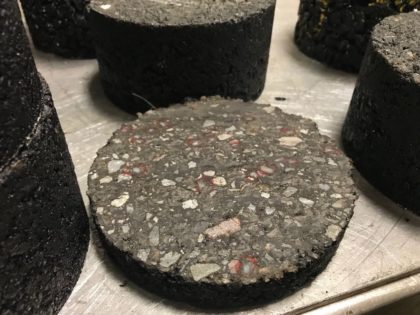
Lanamme. The red circles show pieces of plastic used for the tests.
A new project takes Costa Rica to the forefront in environmental matters again. The plastic bottles, those that regularly end up in the dumpster of your house, will be one of the components of the asphalt mix to be placed on the roads.
Although the University of Costa Rica (UCR) has been investigated this possibility for nearly 20 years, it was not until this Tuesday that it was announced the new mixture called “green asphalt” is now at the end of the design period. It will finish its laboratory tests and then it will be placed on an internal street of the Municipality of Desamparados to measure its performance in a real scenario.
In Costa Rica, 600 million disposable plastic bottles are produced every year. Thanks to this mixture, a thousand bottles will be used in the production of every ton of asphalt.
Until now, the National Laboratory of Materials and Structural Models (Lanamme) of the UCR managed to determine that the new mixture, in which at least 3% of stone is replaced by crushed plastic, has a good performance. This Tuesday it was announced that they managed to reach an
asphalt layer resistant to malformation, cracking and moisture, among other critical factors, which makes it different from mixtures from other countries,”
such as England, India, and Canada, which have also experimented with this technique. Costa Rica is a leader in Latin America, with its very own components.
The name “green asphalt” refers to the impact that this initiative would have on the environment. Seen as an alternative for environmental sustainability, the bottles would have another destination than the sea.
In Costa Rica, only 10% of the 600 million bottles produced annually are properly treated. The other 90% of the bottles end up accumulated in rivers, coasts and in the ocean. In addition, the extraction of a virgin product (the stone and sand needed for the asphalt mixture) is changed by the reuse of a product that will become a valuable waste. This decreases the energy expenditure to obtain materials.
With this initiative we would be recovering and reusing plastic for the reconstruction of roads,”
said William Segura, manager of Public Affairs and Communications of Coca Cola for Central America, which supports the initiative, because it fits like a glove with the goal set as a company in January of this year: to collect 100% of the non-returnable packaging produced (plastic, aluminum, tetra brick, and others,) by 2030. Currently, this collection reaches 30%.
After the construction of this road for testing, a machine will be taken out of the Lanamme for the first time to measure the quality of the new asphalt. It is a vehicle simulator that is able to imitate the factors that produce road wear, such as vehicle load and humidity, but in less time.